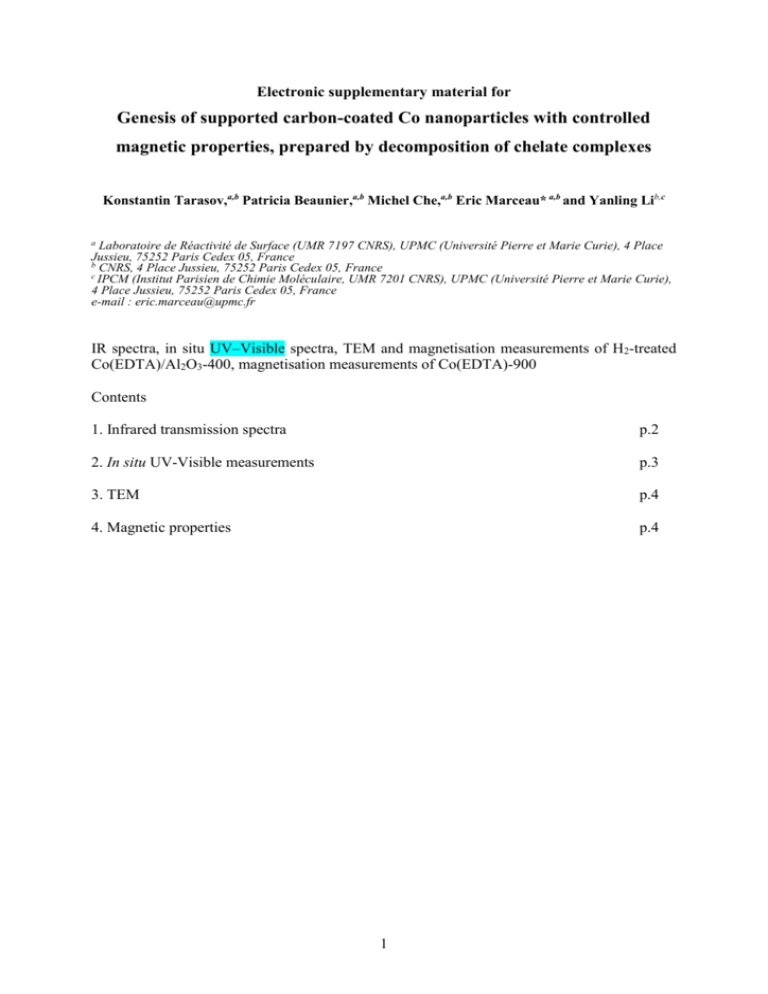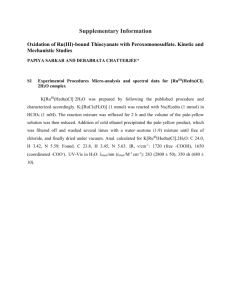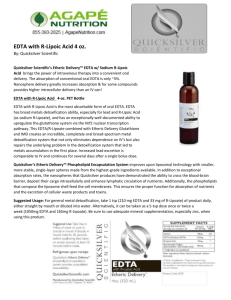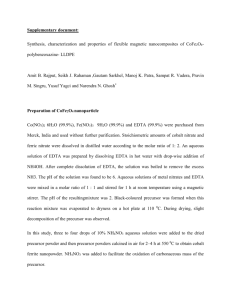EXAFS, tables - Springer Static Content Server
advertisement

Electronic supplementary material for Genesis of supported carbon-coated Co nanoparticles with controlled magnetic properties, prepared by decomposition of chelate complexes Konstantin Tarasov,a,b Patricia Beaunier,a,b Michel Che,a,b Eric Marceau* a,b and Yanling Lib,c a Laboratoire de Réactivité de Surface (UMR 7197 CNRS), UPMC (Université Pierre et Marie Curie), 4 Place Jussieu, 75252 Paris Cedex 05, France b CNRS, 4 Place Jussieu, 75252 Paris Cedex 05, France c IPCM (Institut Parisien de Chimie Moléculaire, UMR 7201 CNRS), UPMC (Université Pierre et Marie Curie), 4 Place Jussieu, 75252 Paris Cedex 05, France e-mail : eric.marceau@upmc.fr IR spectra, in situ UV–Visible spectra, TEM and magnetisation measurements of H2-treated Co(EDTA)/Al2O3-400, magnetisation measurements of Co(EDTA)-900 Contents 1. Infrared transmission spectra p.2 2. In situ UV-Visible measurements p.3 3. TEM p.4 4. Magnetic properties p.4 1 1. Infrared transmission spectra Infrared (IR) spectra recorded using KBr pellets were collected with a FT-IR M-1700 PerkinElmer spectrometer with a 4 cm-1 resolution. Co(EDTA)/Al2O3-400 Co(EDTA)/Al2O3 3435 1621 1514 1413 Absorbance (CH) (OH) 2971 2927 2853 1595 (COO ) s 1400 (CH ) - 3435 (NH) 2 1438 3210 (CH) 2973 2925 2855 1325 1104 1281 (H O) 2 0.1 (COO ) - as 3500 3000 2500 1800 1600 1400 1200 1000 -1 Wavenumber (cm ) Fig.1s. Infrared transmission spectra of Co(EDTA)/Al2O3 and Co(EDTA)/Al2O3-400 (recorded at room temperature in KBr). The IR spectrum of Co(EDTA)/Al2O3 exhibits bands which are characteristic of [Co(EDTA)]2- (Nakamoto 1987; Tarasov, O’Hare et al. 2003): C-H vibrations in the region of 2850-3000 cm-1, C-N vibrations at ~ 1100 cm-1, and strong asymmetrical and symmetrical COO vibrations at ~1600 and ~1400 cm-1, respectively. Nakamoto K (1987) Infrared and Raman spectra of inorganic compounds. Wiley-Interscience, New York Tarasov KA, O'Hare D, Isupov VP (2003) Solid-state chelation of metal ions by ethylenediaminetetraacetate intercalated in a layered double hydroxide. Inorg Chem 42:1919-1927. doi: 10.1021/ic0203926 2 2. In situ UV-Visible measurements UV-vis diffuse reflectance spectra were recorded in the reflectance mode with a resolution of 1 nm on a Cary 5 spectrometer (Varian) equipped with an integration sphere, a praying mantis device and BaSO4 as reference. The spectra were collected in situ in the range 20-300°C using a high temperature environmental cell (Spectratech). 300°C (recorded at 20°C) 300°C (recorded at 20°C) 536 565 215°C 215°C 150°C 150°C 20°C 20°C 536 571 2282 2345 1703 1740 1189 2197 2040 Absorbance (KM) Absorbance (KM) 531 565 1189 519 1160 2182 1701 1744 2040 1114 2181 1703 1747 2040 (OH) 2043 1961 2(OH) 1391 0.2 2(NH) 1574 2(CH) 1703 0.1 500 1000 1500 Wavelength (nm) 2000 2500 2285 2339 1391 2171 381 2285 2339 1400 1600 2283 2345 (CH) (NH) 1738 1800 2000 2200 Wavelength (nm) 2400 Fig.2s. UV-Visible-NIR spectra of Co(EDTA)/Al2O3 recorded in in situ diffuse reflectance conditions (praying mantis and environmental cell, He flow 50 mL.min-1, temperature ramp 7.5°min-1). The minor band at 381 nm corresponds to Co(III)-EDTA complexes resulting from the oxidation in solution of a fraction of the Co(II) precursor. On the right – zoom of the NIR region. The positions of the two main absorption bands observed in the UV-vis spectrum are characteristic of Co2+ cations in octahedral coordination with EDTA: an asymmetric band at 519 nm (4T1g(F) – 4T1g(P) transition) with a shoulder at 620 nm ( 4Т1g – 4A2g transition), and a broad band at 1114 nm corresponding to the 4T1g – 4T2g transition (Tarasov, O’Hare et al. 2003; Mhamdi et al. 2005). During the heating process, the sample turns violet, but the metal cations retain their oxidation state (II) as evidenced by the two slightly shifted absorption bands detected by in situ UV-Vis measurements. In line with thermal analysis, bands associated with O-H vibrations in the near-infrared region disappear below 150°C, while bands assigned to N-H vibrations disappear progressively between 150 and 300°C. Tarasov KA, O'Hare D, Isupov VP (2003) Solid-state chelation of metal ions by ethylenediaminetetraacetate intercalated in a layered double hydroxide. Inorg Chem 42:1919-1927. doi: 10.1021/ic0203926 Mhamdi M, Marceau E, Khaddar-Zine S, Ghorbel A, Che M, Ben Taarit Y, Villain F (2005) Preparation of Co2+/ZSM5 catalysts by solid-state reaction: influence of the precursor on cobalt speciation. Z Phys Chem 219:963-978. doi: 10.1524/zpch.219.7.963.67087 3 3. TEM Co(EDTA)/Al2O3 – 400 / H2 Fig. 4s. TEM image of Co(EDTA)/Al2O3-400 treated in H2 at 400°C. 4. Magnetic properties 2 1 Hc = 330 Oe M (emu/g) 1 0 0 -1 -2000 -1000 0 1000 2000 -1 -2 -40000 -20000 0 20000 40000 H (Oe) Fig. 5s. Magnetisation dependence M(H) recorded at 293 K of Co(EDTA)/Al2O3- 400 treated in H2 . 4 20 6 15 3 10 0 2K -3 M (emu/g) 5 -6 0 -2 k -1 k 0 1k 2k -5 2K 293 K -10 -15 -20 -40000 -20000 0 20000 40000 H (Oe) Fig. 6s. Magnetization dependences M(H) of Co(EDTA)/Al2O3-900. 5







